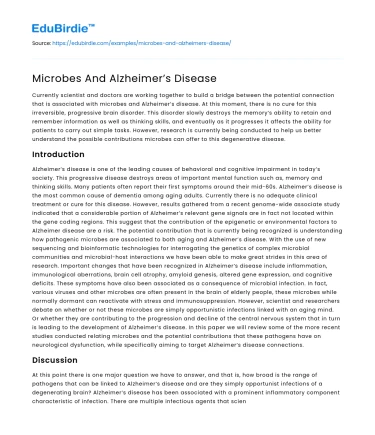Currently scientist and doctors are working together to build a bridge between the potential connection that is associated with microbes and Alzheimer’s disease. At this moment, there is no cure for this irreversible, progressive brain disorder. This disorder slowly destroys the memory’s ability to retain and remember information as well as thinking skills, and eventually as it progresses it affects the ability for patients to carry out simple tasks. However, research is currently being conducted to help us better understand the possible contributions microbes can offer to this degenerative disease.
Introduction
Alzheimer’s disease is one of the leading causes of behavioral and cognitive impairment in today’s society. This progressive disease destroys areas of important mental function such as, memory and thinking skills. Many patients often report their first symptoms around their mid-60s. Alzheimer’s disease is the most common cause of dementia among aging adults. Currently there is no adequate clinical treatment or cure for this disease. However, results gathered from a recent genome-wide associate study indicated that a considerable portion of Alzheimer’s relevant gene signals are in fact not located within the gene coding regions. This suggest that the contribution of the epigenetic or environmental factors to Alzheimer disease are a risk. The potential contribution that is currently being recognized is understanding how pathogenic microbes are associated to both aging and Alzheimer’s disease. With the use of new sequencing and bioinformatic technologies for interrogating the genetics of complex microbial communities and microbial-host interactions we have been able to make great strides in this area of research. Important changes that have been recognized in Alzheimer’s disease include inflammation, immunological aberrations, brain cell atrophy, amyloid genesis, altered gene expression, and cognitive deficits. These symptoms have also been associated as a consequence of microbial infection. In fact, various viruses and other microbes are often present in the brain of elderly people, these microbes while normally dormant can reactivate with stress and immunosuppression. However, scientist and researchers debate on whether or not these microbes are simply opportunistic infections linked with an aging mind. Or whether they are contributing to the progression and decline of the central nervous system that in turn is leading to the development of Alzheimer’s disease. In this paper we will review some of the more recent studies conducted relating microbes and the potential contributions that these pathogens have on neurological dysfunction, while specifically aiming to target Alzheimer’s disease connections.
Save your time!
We can take care of your essay
- Proper editing and formatting
- Free revision, title page, and bibliography
- Flexible prices and money-back guarantee
Discussion
At this point there is one major question we have to answer, and that is, how broad is the range of pathogens that can be linked to Alzheimer’s disease and are they simply opportunist infections of a degenerating brain? Alzheimer’s disease has been associated with a prominent inflammatory component characteristic of infection. There are multiple infectious agents that scientist have proposed to be the etiological cause of Alzheimer’s. Nonetheless, from what I’ve seen there seems to be a connection between microbes and Alzheimer’s disease. However, with the limited amount of definitive studies produced. I can only presume that either Alzheimer’s patients are particularly subjected to fungal infections for an unknown reason. Or conversely, it also seems possible that the infections being produced are the cause of Alzheimer’s disease or at the minimum a contributor to its etiology. At this point in time I don’t think there is enough research or studies being produced to lead us to an absolute answer.
Conclusion
Furthermore, at this point there seems to be no definitive answer on whether or not these microbes are the cause of neurodegeneration that in turn is leading to Alzheimer’s disease. However, there is defiantly a connection with increased microbes located in those who are suffering from Alzheimer’s disease. Hopefully with more research in the coming years we will be able to create a more definitive correspondence and help clarify this possibility.
Did you like this example?
Make sure you submit a unique essay
Our writers will provide you with an essay sample written from scratch: any topic, any deadline, any instructions.
Cite this paper
-
APA
-
MLA
-
Harvard
-
Vancouver
Microbes And Alzheimer’s Disease.
(2022, July 08). Edubirdie. Retrieved March 4, 2025, from https://hub.edubirdie.com/examples/microbes-and-alzheimers-disease/
“Microbes And Alzheimer’s Disease.” Edubirdie, 08 Jul. 2022, hub.edubirdie.com/examples/microbes-and-alzheimers-disease/
Microbes And Alzheimer’s Disease. [online].
Available at: <https://hub.edubirdie.com/examples/microbes-and-alzheimers-disease/> [Accessed 4 Mar. 2025].
Microbes And Alzheimer’s Disease [Internet]. Edubirdie.
2022 Jul 08 [cited 2025 Mar 4].
Available from: https://hub.edubirdie.com/examples/microbes-and-alzheimers-disease/
copy






 Stuck on your essay?
Stuck on your essay?

